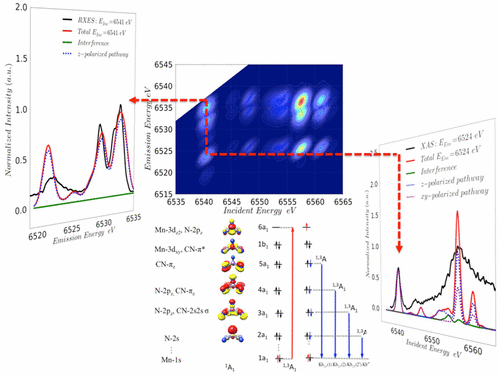当前位置:
X-MOL 学术
›
Inorg. Chem.
›
论文详情
Our official English website, www.x-mol.net, welcomes your
feedback! (Note: you will need to create a separate account there.)
A Restricted Open Configuration Interaction with Singles Method To Calculate Valence-to-Core Resonant X-ray Emission Spectra: A Case Study
Inorganic Chemistry ( IF 4.3 ) Pub Date : 2017-09-18 00:00:00 , DOI: 10.1021/acs.inorgchem.7b01810 Dimitrios Maganas 1 , Serena DeBeer 1 , Frank Neese 1
Inorganic Chemistry ( IF 4.3 ) Pub Date : 2017-09-18 00:00:00 , DOI: 10.1021/acs.inorgchem.7b01810 Dimitrios Maganas 1 , Serena DeBeer 1 , Frank Neese 1
Affiliation

|
In this work, a new protocol for the calculation of valence-to-core resonant X-ray emission (VtC RXES) spectra is introduced. The approach is based on the previously developed restricted open configuration interaction with singles (ROCIS) method and its parametrized version, based on a ground-state Kohn–Sham determinant (DFT/ROCIS) method. The ROCIS approach has the following features: (1) In the first step approximation, many-particle eigenstates are calculated in which the total spin is retained as a good quantum number. (2) The ground state with total spin S and excited states with spin S′ = S, S ± 1, are obtained. (3) These states have a qualitatively correct multiplet structure. (4) Quasi-degenerate perturbation theory is used to treat the spin–orbit coupling operator variationally at the many-particle level. (5) Transition moments are obtained between the relativistic many-particle states. The method has shown great potential in the field of X-ray spectroscopy, in particular in the field of transition-metal L-edge, which cannot be described correctly with particle–hole theories. In this work, the method is extended to the calculation of resonant VtC RXES [alternatively referred to as 1s-VtC resonant inelastic X-ray scattering (RIXS)] spectra. The complete Kramers–Dirac–Heisenerg equation is taken into account. Thus, state interference effects are treated naturally within this protocol. As a first application of this protocol, a computational study on the previously reported VtC RXES plane on a molecular managanese(V) complex is performed. Starting from conventional X-ray absorption spectra (XAS), we present a systematic study that involves calculations and electronic structure analysis of both the XAS and non-resonant and resonant VtC XES spectra. The very good agreement between theory and experiment, observed in all cases, allows us to unravel the complicated intensity mechanism of these spectroscopic techniques as a synergic function of state polarization and interference effects. In general, intense features in the RIXS spectra originate from absorption and emission processes that involve nonorthogonal transition moments. We also present a graphical method to determine the sign of the interference contributions.
中文翻译:

用单原子方法计算价核共振 X 射线发射光谱的限制开放构型相互作用:案例研究
在这项工作中,介绍了一种用于计算价核共振 X 射线发射 (VtC RXES) 光谱的新协议。该方法基于先前开发的受限开放构型相互作用与单粒子 (ROCIS) 方法及其参数化版本,基于基态 Kohn-Sham 行列式 (DFT/ROCIS) 方法。 ROCIS方法具有以下特点: (1)在第一步近似中,计算多粒子本征态,其中总自旋保留为良好的量子数。 (2) 得到总自旋为S的基态和自旋为S ′= S 、 S ±1的激发态。 (3) 这些态具有定性正确的多重态结构。 (4) 准简并微扰理论用于在多粒子水平上变分地处理自旋轨道耦合算子。 (5) 获得相对论性多粒子态之间的跃迁矩。该方法在X射线光谱领域显示出巨大的潜力,特别是在过渡金属L边领域,这是无法用粒子空穴理论正确描述的。在这项工作中,该方法被扩展到共振 VtC RXES [也称为 1s-VtC 共振非弹性 X 射线散射 (RIXS)] 光谱的计算。考虑了完整的 Kramers-Dirac-Heisenerg 方程。因此,在该协议中自然地处理了国家干扰效应。作为该协议的首次应用,对先前报道的分子锰 (V) 复合物上的 VtC RXES 平面进行了计算研究。 从传统的 X 射线吸收光谱 (XAS) 开始,我们提出了一项系统研究,涉及 XAS 以及非共振和共振 VtC XES 光谱的计算和电子结构分析。在所有情况下观察到的理论与实验之间非常一致,使我们能够将这些光谱技术的复杂强度机制解释为状态偏振和干涉效应的协同函数。一般来说,RIXS 光谱中的强烈特征源于涉及非正交跃迁矩的吸收和发射过程。我们还提出了一种图形方法来确定干扰贡献的符号。
更新日期:2017-09-18
中文翻译:

用单原子方法计算价核共振 X 射线发射光谱的限制开放构型相互作用:案例研究
在这项工作中,介绍了一种用于计算价核共振 X 射线发射 (VtC RXES) 光谱的新协议。该方法基于先前开发的受限开放构型相互作用与单粒子 (ROCIS) 方法及其参数化版本,基于基态 Kohn-Sham 行列式 (DFT/ROCIS) 方法。 ROCIS方法具有以下特点: (1)在第一步近似中,计算多粒子本征态,其中总自旋保留为良好的量子数。 (2) 得到总自旋为S的基态和自旋为S ′= S 、 S ±1的激发态。 (3) 这些态具有定性正确的多重态结构。 (4) 准简并微扰理论用于在多粒子水平上变分地处理自旋轨道耦合算子。 (5) 获得相对论性多粒子态之间的跃迁矩。该方法在X射线光谱领域显示出巨大的潜力,特别是在过渡金属L边领域,这是无法用粒子空穴理论正确描述的。在这项工作中,该方法被扩展到共振 VtC RXES [也称为 1s-VtC 共振非弹性 X 射线散射 (RIXS)] 光谱的计算。考虑了完整的 Kramers-Dirac-Heisenerg 方程。因此,在该协议中自然地处理了国家干扰效应。作为该协议的首次应用,对先前报道的分子锰 (V) 复合物上的 VtC RXES 平面进行了计算研究。 从传统的 X 射线吸收光谱 (XAS) 开始,我们提出了一项系统研究,涉及 XAS 以及非共振和共振 VtC XES 光谱的计算和电子结构分析。在所有情况下观察到的理论与实验之间非常一致,使我们能够将这些光谱技术的复杂强度机制解释为状态偏振和干涉效应的协同函数。一般来说,RIXS 光谱中的强烈特征源于涉及非正交跃迁矩的吸收和发射过程。我们还提出了一种图形方法来确定干扰贡献的符号。











































 京公网安备 11010802027423号
京公网安备 11010802027423号